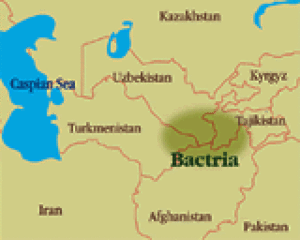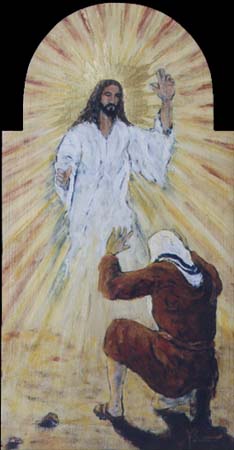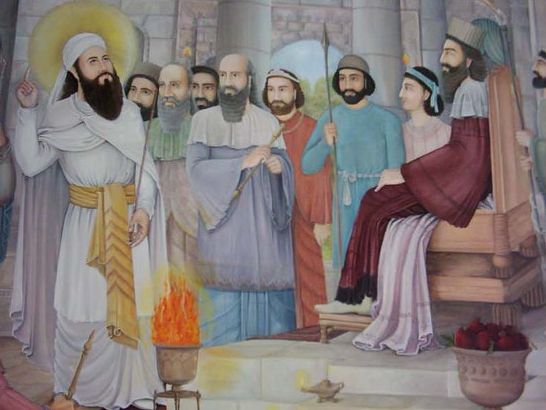
History of Zoroaster

At that time the Aryans worshipped many gods and goddesses, with very complicated rites; very similar to the Brahminism of India. The Aryans were divided into castes of priests (Brahmins), warrior-knights, artisans, and workers. The priests taught the people that they had to make sacrifices to the rain god to get rain, to the cattle god if their cattle were sick, to the sky gods, to gods of fertility to make sure their crops grew, their babies were born healthy, etc.
Young Zoroaster was a Seeker of Truth. He would spend many hours asking the priests various questions, and was not satisfied with most of their answers. Then one day, while gatering water on the banks of the Oxus, when he was 30 years old, Zoroaster was visited by a Cosmic Being called Vohu Manah (Good Mind) who taught him the "Religion of the Good Mind"; what became known as "the Good Religion".

Vohu Manah (Vohuman) taught Zoroaster the "the Way of the Good Mind"; the first Revelation of the Supreme Being (Ahura Mazda) to mankind. The Way of the Good Mind became known as:
*The Way
*The Good Religion
*Zoroastrianism
Most Zoroastrians refer to it simply as "the Good Religion".
Zoroaster composed a series of 17 Hymns called "Gathas" that composed the core of the Good Religion. Here is one:
Listen to the best things with your earsHe began to sing these hymns to others, and others would sing the hymns. He preached against the caste system, and referred to the gods and goddesses of the priests as "demons". He called for all two-legged creatures (humans) to forsake the "Religion of Demons" and to embrace the worship of the Ahura Mazda ("Supreme-Being Super-Wise") and become Mazdayasni ("Mazda-worshippers").
Reflect upon them with clear thought.
And choose between the two ways of thinking.
At the world’s end
He, of holier spirit, that chooses the Right
And shall inherit the Best existence
He that follows the Lie and chooses the worst
Shall inherit the worst existence
If you choose wrongly and rush to violence
You enfeeble the world of men.
If the right choice is made
Then, in the hereafter, all shall be well
[Free translation from the Gathas, or Songs of Zarathustra, section 3:2]
The priestly-caste were enraged, and tried to persecute and kill Zoroaster, but he was miraculously saved many times. Then, Zoroaster converted the King of Bactria, King Vishtaspa, who then made the Good Religion the official religion of Bactria. Over the centuries, the Zoroastrians of Bactria (who spoke an Aryan dialect) converted the other Aryans to the West in what is now Iran.

Zoroaster taught the following:
*Ahura Mazda is the Supreme Being; assisted by six Holy Immortals. The first of these, Vohu Manah (Good Thought) is the "Son" of Ahura Mazda, and the Being through which Ahura Mazda created the Cosmos.
*We all have freedom of choice between good and bad, light and darkness.
*Each of us has a guardian angel called a Fravashi who records our deeds good and bad and sometimes communicates to us, or comes to our aid in danger.
*We are all judged solely by our actions (words/thoughts/deeds) in life; nothing else.
*At death those whose good deeds outweigh their bad deeds go to Paradise. Those who bad deeds outweigh their good deeds "return to the House of Fire". Those whose good and bad deeds were equal, go to Limbo.
*Three Sayoshants (Saviors) shall arise from the descendants of Zoroaster, all born of virgins. The last one will cause the resurrection of the dead.
*The essence of the Good Religion is Good Thoughts/Good Words/Good Deeds.
With the sanction of King Vishtaspa, the Good Religion became the state religion of Bactria, and spread very rapidly to the other Aryan tribes to the East and West.
Among the Aryans were a special caste of Astrologers called the Magavan (Avestan: "great ones"). There were men-women; meaning individuals born with male and female organs (i.e. hermaphrodytes). The Aryans considered these people to be "great beings" with latent powers of divination and healing, and the interpretation of dreams. They became known as "Magians" or "Magoi" or "Magi".
In the year 963, a Muslim named Hasan bar Bahlul claimed to have be told by the Magians about a Magian book called the Book of Abhasta. In that book, the Magians claim that Zoroaster converted three Magians to the Good Religion, and told them the following:
In the latter-days a maiden, a daughter of the Hebrews, will have a son in the flesh, but without connection [sexual intercourse], who shall have a godly nature. At his birth a star will appear. Go ye! Offer him gifts of of gold, myrhh, and frankensense."Zoroaster established "Fire Temples" where flames were kept lit 24 hours per day. He taught that fire was the "essence" of Ahura Mazda on earth.